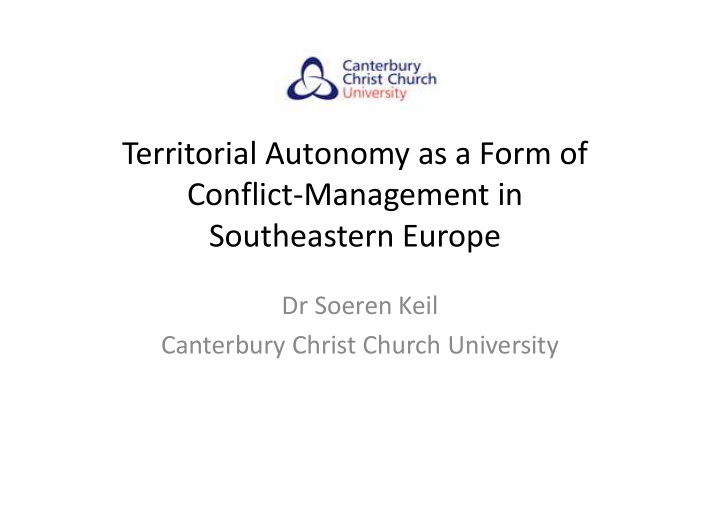



Territorial Autonomy as a Form of Conflict-Management in Southeastern Europe Dr Soeren Keil Canterbury Christ Church University
Structure • Introduction: What is Territorial Autonomy? • Territorial Autonomy in Southeastern Europe • Territorial Autonomy as a Form of Conflict Resolution • Remaining Problems
There are no territorial solutions to ethnic issues. Ohrid Framework Agreement, 2001, Art. 1.2
Introduction • See quote from OFA � yet, territorial decentralisation has been at the heart of solving ethnic conflicts in Southeastern Europe • With territorial autonomy I refer to territorial decentralisation (to different degrees), usually used to ensure self-governance for different ethnic groups
Introduction • This research is based on an earlier project, in which I examined the federal system in Bosnia and Herzegovina (Book forthcoming: S. Keil: Multinational Federalism in Bosnia and Herzegovina , Ashgate, 2013) and on a number of joint papers with Prof Florian Bieber, in which we examined different models of power-sharing in the Western Balkans • It fits in with my current interest in European foreign policy in the Western Balkans and the establishment of a security community in the post-Yugoslav area
Introduction Conflicts in • Based on questions of state dissolution and succession Southeastern • Deeply ethnical nature • Focus: Creation of homogenous nation-states Europe • Usually involved international actors (EU and USA) • Washington Agreement (1994) Conflict • Dayton Peace Agreement (1995) Management • UNSC Resolution 1244 (1999) • Ohrid Framework Agreement (2001) • Ahtisaari Plan (2007) Power- • Elite Cooperation (usually grand coalitions) • Veto Rights Sharing • Proportional Representation • Autonomy
Territorial Autonomy in Southeastern Europe • We find different forms of territorial autonomy • Croatia • Serbia Centralised • Macedonia • Kosovo Decentralised • Serbia and Montenegro (until 2006) • Bosnia and Herzegovina Federalised
Territorial Autonomy in Southeastern Europe • The three countries I am interested in are Bosnia and Herzegovina, Macedonia and Kosovo • In all three countries territorial autonomy has been used to manage ongoing ethnic conflicts and provide different ethnic groups with self- governance in their territorial unit(s)
Territorial Autonomy in Southeastern Europe • Bosnia and Herzegovina � 1995 Dayton Peace Agreement � Bosnia federalised, consisting of 2 entities � Decision-making highly decentralised � State held together by weak central institutions and external actors (NATO troops, OHR) � Until 2006 process of functional centralisation
Territorial Autonomy in Southeastern Europe • Macedonia � 2001 Ohrid Framework Agreement � Strong focus on decentralisation � But no federalisation, central state remains of key importance in the system
Territorial Autonomy in Southeastern Europe
Territorial Autonomy in Southeastern Europe • Kosovo � Decentralisation part of the Ahtisaari Plan (2007) � First attempts already in 2001 (Constitutional Framework) � Since 2008 implemented by Kosovo government � “One of the few success stories of independent Kosovo” (G. Krasniqi)
Territorial Autonomy in Southeastern Europe
Territorial Autonomy as a Form of Conflict Resolution • In all three cases, territorial autonomy has been used to address violent conflicts • The different intensity and nature of the conflicts helps to explain the different forms of territorial autonomy (and power-sharing more generally) • International actors played a key role in the design and implementation of peace agreements and constitutional frameworks that included these territorial arrangements
Territorial Autonomy as a Form of Conflict Resolution • Simple Idea: Separate hostile groups, provide them with lots of self-governance and make sure that the different groups are forced to work together in central state institutions • Implementation: Strong focus on self- governance via territorial autonomy and strong focus on grand coalitions and veto rights in central institutions
Territorial Autonomy as a Form of Conflict Resolution • The Problem: Ethnic conflicts are characterised by identity issues: Deep rooted and hard to solve • Settlement of certain groups does not follow the logic of ethnically homogenous regions (see: Serb flight from Sarajevo, clear division of Skopje, homogenisation of Southern Kosovo)
Territorial Autonomy as a Form of Conflict Resolution • The Answer…. 1. External Military Presence to ensure peaceful implementation of agreements (IFOR/SFOR in Bosnia, NATO and EUFOR in Macedonia, KFOR in Kosovo) 2. Political pressure by external actors to implement peace arrangements (most notably: EU conditionality) 3. Building of a regional security community to make conflict more unlikely (Stability Pact, RCC, Cooperation in Energy Policy, CEFTA)
Remaining Problems 1. Territorial issues are not solved (see demand for third entity by Bosnian Croats, Demands for federalisation by Albanians in Macedonia) 2. Sovereignty issues are not solved (see Northern Kosovo, Republika Srpska) 3. “The Pull of Brussels” is not enough: Limited impact of EU on situation in Bosnia, Macedonia and Kosovo
Remaining Problems • There are a number of states in Southeastern Europe who are not saturated (i.e. where a high percentage of the ethnic kin group lives outside of the state’s borders and therefore these are incomplete nation states) • Some states remain fundamentally challenged internally and externally (Bosnia and Kosovo, but also Macedonia) • Principle ideas of liberal interventionism and state- building have failed (so far?) in Bosnia, Kosovo and Macedonia • So what is the alternative?
Thank you very much! I welcome your questions and comments! Dr Soeren Keil Canterbury Christ Church University Email: soeren.keil@canterbury.ac.uk
Recommend
More recommend